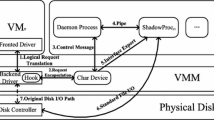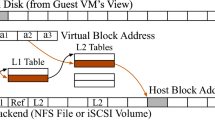Abstract
Due to offering fast random-access disk I/O, it appears that solid-state drives (SSD), which is based on NAND flash memory, can suit well with the environment of cloud computing, especially for the cloud providing video streaming services. However, by investigating a practical virtual desktop system, where runs video streaming workloads, we find that importing this kind of SSDs into a virtualized system is not as simple as merely a mechanical replacement. Because a large proportion of disk I/O being included in the video streaming workload is write I/O, the inherent weaknesses of NAND flash memory, write amplification (WA), will be magnified in a guest operating system (OS). Worse, some useful remedies in a native OS become disabled or inefficient due to the interposition of hypervisor layer. This paper describes and analyzes these problems based on a practical virtual desktop system, and then proposes a tailor-made method to relieve them. By evaluating realistic user workloads and several typical benchmarks, the result shows that our method can effectively improve these problems in our virtualized SSD system.








Similar content being viewed by others
Notes
To avoid the WA as much as possible, a native SSD system often uses TRIM command to physically delete the invalid files in its NAND flash memory for increasing the clean space.
Flash memory can only be programmed and erased a limited number of times. This is often referred to as the maximum number of program/erase cycles (P/E cycles) it can sustain over the life of the flash memory. This metric largely depends on the number of rewrite that SSD has served.
This SSD device has similar specification with Intel X25-M G2.
To clarify the point that how a virtualized SSD device affects guest write in this paper, we ignore all read requests on figure plotting. However, we will include them into the trace analysis by strictly referencing the original trace file.
This kind of SSD devices usually have a good performance on handling rewrite operations but often trading with expensive price.
The offset field refers to an offset from the starting position of a guest image file.
We also conduct a series of experiments by using 2 GB and 4 GB testing file size. But we find that the result of relative performance between VFlashCache and its counterpart is quite similar with the case of 1 GB size (the margin of error is about 1.5 percentage points). Therefore, we ignore them in this paper.
References
Agrawal N, Prabhakaran V,Wobber T, Davis JD, Manasse M, Panigrahy R (2008) Design tradeoffs for SSD performance. In: Proceedings of the USENIX 2008 annual technical conference (USENIX 2008). USENIX Association, Berkeley, CA, pp 57–70
Amazon.com (2012) http://www.amazon.com
Apple—iPhoto (2012) http://www.apple.com/ilife/iphoto/
Application Acceleration Enterprise Flash Memory Platform (2012) http://www.fusionio.com/solutions/virtualization/
Chen F, Luo T, Zhang X (2011) CAFTL: a content-aware flash translation layer enhancing the lifespan of flash memory based solid state drives. In: Proceedings of the 9th USENIX conference on file and storage technologies (FAST 2011). USENIX Association, Berkeley, CA
Gal E, Toledo S (2005) ACM Comput Surv (CSUR) 37(2):138
Ganger G (2011) The DiskSim simulation environment (v4.0). http://www.pdl.cmu.edu/DiskSim/
Ghemawat S, Gobioff H, Leung ST (2003) The Google file system. In: Proceedings of the 19th ACM Symposium on Operating Systems Principles (SOSP 2003). ACM, New York, NY, pp 29–43
Grupp L, Davis J, Swanson S (2012) The bleak future of NAND flash memory. In: Proceedings of the USENIX conference on file and storage technologies (FAST)
Gulati A, Merchant A, Varman P (2010) mClock: handling throughput variability for hypervisor IO scheduling. In: Proceedings of the 9th USENIX conference on operating systems design and implementation (OSDI 2010). USENIX, Vancouver, BC, pp 437–450
Harter T, Dragga C, Vaughn M, Arpaci-Dusseau AC, Arpaci-Dusseau RH (2011) A file is not a file: understanding the I/O behavior of apple desktop applications. In: Proceedings of the 23th ACM symposium on operating systems principles (SOSP 2011). ACM, New York, NY, pp 71–83
Hildebrand D, Povzner A, Tewari R, Tarasov V (2011) Revisiting the storage stack in virtualized NAS environments. In: Proceedings of the 3rd conference on I/O virtualization (WIOV 2011). USENIX Association, Berkeley, CA
Hu XY, Eleftheriou E, Haas R, Iliadis I, Pletka R (2009) Write amplification analysis in flash-based solid state drives. In: Proceedings of the Israeli experimental systems conference (SYSTOR 2009). ACM, New York, NY, pp 10:1–10:9
Intel Solid-State DriveOptimizer (2009) http://download.intel.com/design/flash/nand/mainstream/Intel_SSD_Optimizer_White_Paper.pdf
Jo H, Kwon Y, Kim H, Seo E, Lee J, Maeng S (2009) SSD-HDD-Hybrid virtual disk in consolidated environments. In: Proceedings of the 2009 international conference on parallel processing (EuroPar 2009), pp 375–384
Kim S, Kim J, Maeng S (2012) Using Solid-State Drives (SSDs) for virtual block devices. In: Proceedings of the runtime environments, systems, layering and virtualized environments (RESoLVE’12)
Le D, Huang H, Wang H (2012) Understanding performance implications of nested file systems in a virtualized environment. In: Proceedings of the USENIX conference on file and storage technologies (FAST)
Liao X, Jin H, Hu L, Liu H (2010) Towards virtualized desktop environment. Concurrency and Computation: Practice and Experience 22(4):419–440
Narayanan D, Thereska E, Donnelly A, Elnikety S, Rowstron A (2009) Migrating server storage to SSDs: analysis of tradeoffs. In: Proceedings of the 4th ACM European conference on computer systems (EuroSys 2009). ACM, New York, NY, pp 145–158
OCZ LAUNCHES Z-DRIVE R4 CLOUDSERV (2012) http://www.ocztechnology.com/aboutocz/press/2012/481
Open Source P2P video Streaming Software (2012) http://www.scvi.net/stream/soft.htm
Rosenblum M, Waldspurger C (2011) I/O virtualization. ACM Queue 9(30):30–39
Shimpi A (2010) Kingston SSDNow V+100 review. http://www.anandtech.com/show/4010/kingston-ssdnow-v-plus-100-review
Warfield A, Hand S, Fraser K, Deegan T (2005) Facilitating the development of soft devices. In: Proceedings of the annual conference on USENIX annual technical conference (USENIX 2005). USENIX, Anaheim, CA, pp 379–382
Acknowledgements
This work is supported by China National Natural Science Foundation (NSFC) under grants 61272408, 61133006, National High-tech R and D Program of China (863 Program) under grant No. 2012AA010905 and Hubei Funds for Distinguished Young Scientists under grant No. 2012FFA007.
Author information
Authors and Affiliations
Corresponding author
Rights and permissions
About this article
Cite this article
Li, D., Jin, H., Liao, X. et al. Improving write amplification in a virtualized and multimedia SSD system. Multimed Tools Appl 74, 63–83 (2015). https://doi.org/10.1007/s11042-013-1497-6
Published:
Issue Date:
DOI: https://doi.org/10.1007/s11042-013-1497-6




